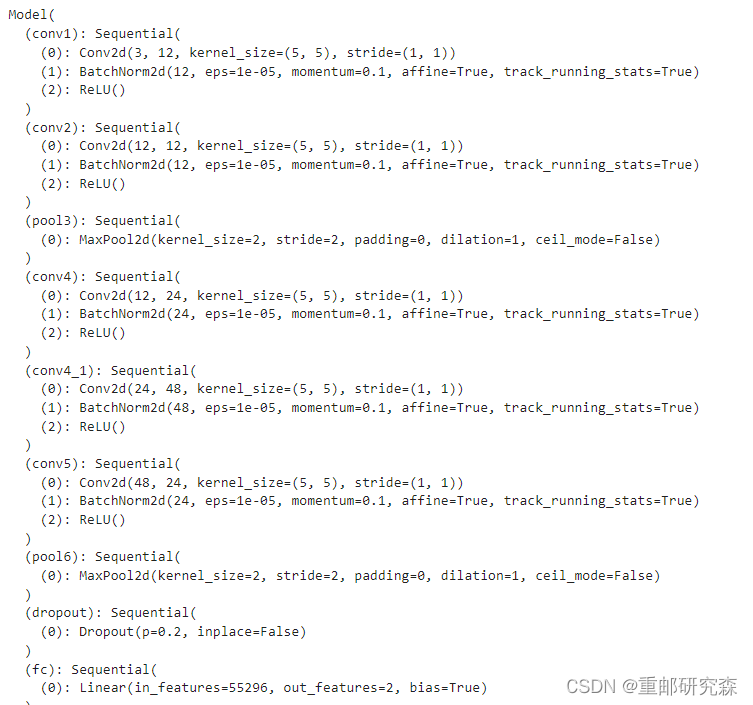-
pytorch-实现运动鞋品牌识别
- 🍨 本文为🔗365天深度学习训练营 中的学习记录博客
- 🍦 参考文章:【365天深度学习训练营-第P5周:运动鞋识别 (yuque.com)】
- 🍖 原作者:K同学啊|接辅导、项目定制
我的环境
- 语言环境:Python3.6
- 编译器:jupyter lab
- 深度学习环境:pytorch1.10
- 参考文章:本人博客(60条消息) 机器学习之——tensorflow+pytorch_重邮研究森的博客-CSDN博客
🍺要求:
- 了解如何设置动态学习率(重点)(✔)
- 调整代码使测试集accuracy到达84%。(✔)
🍻拔高(可选):
- 保存训练过程中的最佳模型权重(✔)
- 调整代码使测试集accuracy到达86%。(✔)
目录
一 前期工作
环境:python3.6,1080ti,pytorch1.10(实验室服务器的环境😂😂)
- import torch
- import torch.nn as nn
- import matplotlib.pyplot as plt
- import torchvision
- device = torch.device("cuda" if torch.cuda.is_available() else "cpu")
- device
2.导入数据
- import os,PIL,random,pathlib
- data_dir = './46-data/'
- data_dir = pathlib.Path(data_dir)
- data_paths = list(data_dir.glob('*'))
- classeNames = [str(path).split("/")[1] for path in data_paths]
- classeNames
二 数据预处理
数据格式设置
- # 关于transforms.Compose的更多介绍可以参考:https://blog.csdn.net/qq_38251616/article/details/124878863
- train_transforms = transforms.Compose([
- transforms.Resize([224, 224]), # 将输入图片resize成统一尺寸
- # transforms.RandomHorizontalFlip(), # 随机水平翻转
- transforms.ToTensor(), # 将PIL Image或numpy.ndarray转换为tensor,并归一化到[0,1]之间
- transforms.Normalize( # 标准化处理-->转换为标准正太分布(高斯分布),使模型更容易收敛
- mean=[0.485, 0.456, 0.406],
- std=[0.229, 0.224, 0.225]) # 其中 mean=[0.485,0.456,0.406]与std=[0.229,0.224,0.225] 从数据集中随机抽样计算得到的。
- ])
- test_transform = transforms.Compose([
- transforms.Resize([224, 224]), # 将输入图片resize成统一尺寸
- transforms.ToTensor(), # 将PIL Image或numpy.ndarray转换为tensor,并归一化到[0,1]之间
- transforms.Normalize( # 标准化处理-->转换为标准正太分布(高斯分布),使模型更容易收敛
- mean=[0.485, 0.456, 0.406],
- std=[0.229, 0.224, 0.225]) # 其中 mean=[0.485,0.456,0.406]与std=[0.229,0.224,0.225] 从数据集中随机抽样计算得到的。
- ])
- train_dataset = datasets.ImageFolder("./46-data/train/",transform=train_transforms)
- test_dataset = datasets.ImageFolder("./46-data/test/",transform=train_transforms)
设置dataset
- batch_size = 32
- train_dl = torch.utils.data.DataLoader(train_dataset,
- batch_size=batch_size,
- shuffle=True,
- num_workers=1)
- test_dl = torch.utils.data.DataLoader(test_dataset,
- batch_size=batch_size,
- shuffle=True,
- num_workers=1)
检查数据格式
- for X, y in test_dl:
- print("Shape of X [N, C, H, W]: ", X.shape)
- print("Shape of y: ", y.shape, y.dtype)
- break

三 搭建网络
- import torch.nn.functional as F
- class Model(nn.Module):
- def __init__(self):
- super(Model, self).__init__()
- self.conv1=nn.Sequential(
- nn.Conv2d(3, 12, kernel_size=5, padding=0), # 12*220*220
- nn.BatchNorm2d(12),
- nn.ReLU())
- self.conv2=nn.Sequential(
- nn.Conv2d(12, 12, kernel_size=5, padding=0), # 12*216*216
- nn.BatchNorm2d(12),
- nn.ReLU())
- self.pool3=nn.Sequential(
- nn.MaxPool2d(2)) # 12*108*108
- self.conv4=nn.Sequential(
- nn.Conv2d(12, 24, kernel_size=5, padding=0), # 24*104*104
- nn.BatchNorm2d(24),
- nn.ReLU())
- self.conv4_1=nn.Sequential(
- nn.Conv2d(24, 48, kernel_size=5, padding=0), # 24*100*100
- nn.BatchNorm2d(48),
- nn.ReLU())
- self.conv5=nn.Sequential(
- nn.Conv2d(48, 24, kernel_size=5, padding=0), # 24*96*96
- nn.BatchNorm2d(24),
- nn.ReLU())
- self.pool6=nn.Sequential(
- nn.MaxPool2d(2)) # 24*48*48
- self.dropout = nn.Sequential(
- nn.Dropout(0.2))
- self.fc=nn.Sequential(
- nn.Linear(24*48*48, len(classeNames)))
- def forward(self, x):
- batch_size = x.size(0)
- x = self.conv1(x) # 卷积-BN-激活
- x = self.conv2(x) # 卷积-BN-激活
- x = self.pool3(x) # 池化
- x = self.conv4(x) # 卷积-BN-激活
- x = self.conv4_1(x)
- x = self.conv5(x) # 卷积-BN-激活
- x = self.pool6(x) # 池化
- x = self.dropout(x)
- x = x.view(batch_size, -1) # flatten 变成全连接网络需要的输入 (batch, 24*50*50) ==> (batch, -1), -1 此处自动算出的是24*50*50
- x = self.fc(x)
- return x
- device = "cuda" if torch.cuda.is_available() else "cpu"
- print("Using {} device".format(device))
- model = Model().to(device)
- model
打印网络结构

四 训练模型
1.设置学习率
- def adjust_learning_rate(optimizer, epoch, start_lr):
- # 每 2 个epoch衰减到原来的 0.98
- lr = start_lr * (0.92 ** (epoch // 2))
- for param_group in optimizer.param_groups:
- param_group['lr'] = lr
- learn_rate = 1e-4 # 初始学习率
- optimizer = torch.optim.SGD(model.parameters(), lr=learn_rate)
2.模型训练
训练函数
- # 训练循环
- def train(dataloader, model, loss_fn, optimizer):
- size = len(dataloader.dataset) # 训练集的大小
- num_batches = len(dataloader) # 批次数目, (size/batch_size,向上取整)
- train_loss, train_acc = 0, 0 # 初始化训练损失和正确率
- for X, y in dataloader: # 获取图片及其标签
- X, y = X.to(device), y.to(device)
- # 计算预测误差
- pred = model(X) # 网络输出
- loss = loss_fn(pred, y) # 计算网络输出和真实值之间的差距,targets为真实值,计算二者差值即为损失
- # 反向传播
- optimizer.zero_grad() # grad属性归零
- loss.backward() # 反向传播
- optimizer.step() # 每一步自动更新
- # 记录acc与loss
- train_acc += (pred.argmax(1) == y).type(torch.float).sum().item()
- train_loss += loss.item()
- train_acc /= size
- train_loss /= num_batches
- return train_acc, train_loss
测试函数
- def test (dataloader, model, loss_fn):
- size = len(dataloader.dataset) # 测试集的大小
- num_batches = len(dataloader) # 批次数目, (size/batch_size,向上取整)
- test_loss, test_acc = 0, 0
- # 当不进行训练时,停止梯度更新,节省计算内存消耗
- with torch.no_grad():
- for imgs, target in dataloader:
- imgs, target = imgs.to(device), target.to(device)
- # 计算loss
- target_pred = model(imgs)
- loss = loss_fn(target_pred, target)
- test_loss += loss.item()
- test_acc += (target_pred.argmax(1) == target).type(torch.float).sum().item()
- test_acc /= size
- test_loss /= num_batches
- return test_acc, test_loss
具体训练代码
- loss_fn = nn.CrossEntropyLoss() # 创建损失函数
- epochs = 40
- min_acc = 0
- train_loss = []
- train_acc = []
- test_loss = []
- test_acc = []
- for epoch in range(epochs):
- # 更新学习率(使用自定义学习率时使用)
- adjust_learning_rate(optimizer, epoch, learn_rate)
- model.train()
- epoch_train_acc, epoch_train_loss = train(train_dl, model, loss_fn, optimizer)
- # scheduler.step() # 更新学习率(调用官方动态学习率接口时使用)
- model.eval()
- epoch_test_acc, epoch_test_loss = test(test_dl, model, loss_fn)
- if epoch_test_acc > min_acc :
- min_acc = epoch_test_acc
- print("save model")
- # 保存模型语句
- PATH = './bestmodel'+'%d'%epoch+'.pth' # 保存的参数文件名
- torch.save(model.state_dict(), PATH )
- else :
- print("不能保存")
- train_acc.append(epoch_train_acc)
- train_loss.append(epoch_train_loss)
- test_acc.append(epoch_test_acc)
- test_loss.append(epoch_test_loss)
- # 获取当前的学习率
- lr = optimizer.state_dict()['param_groups'][0]['lr']
- template = ('Epoch:{:2d}, Train_acc:{:.1f}%, Train_loss:{:.3f}, Test_acc:{:.1f}%, Test_loss:{:.3f}, Lr:{:.2E}')
- print(template.format(epoch+1, epoch_train_acc*100, epoch_train_loss,
- epoch_test_acc*100, epoch_test_loss, lr))
- print('Done')

五 模型评估
1.Loss和Accuracy图
- import matplotlib.pyplot as plt
- #隐藏警告
- import warnings
- warnings.filterwarnings("ignore") #忽略警告信息
- plt.rcParams['font.sans-serif'] = ['SimHei'] # 用来正常显示中文标签
- plt.rcParams['axes.unicode_minus'] = False # 用来正常显示负号
- plt.rcParams['figure.dpi'] = 100 #分辨率
- epochs_range = range(epochs)
- plt.figure(figsize=(12, 3))
- plt.subplot(1, 2, 1)
- plt.plot(epochs_range, train_acc, label='Training Accuracy')
- plt.plot(epochs_range, test_acc, label='Test Accuracy')
- plt.legend(loc='lower right')
- plt.title('Training and Validation Accuracy')
- plt.subplot(1, 2, 2)
- plt.plot(epochs_range, train_loss, label='Training Loss')
- plt.plot(epochs_range, test_loss, label='Test Loss')
- plt.legend(loc='upper right')
- plt.title('Training and Validation Loss')
- plt.show()

2.对结果进行预测
- from PIL import Image
- classes = list(train_dataset.class_to_idx)
- def predict_one_image(image_path, model, transform, classes):
- test_img = Image.open(image_path).convert('RGB')
- # plt.imshow(test_img) # 展示预测的图片
- test_img = transform(test_img)
- img = test_img.to(device).unsqueeze(0)
- model.eval()
- output = model(img)
- _,pred = torch.max(output,1)
- pred_class = classes[pred]
- print(f'预测结果是:{pred_class}')
- # 预测训练集中的某张照片
- predict_one_image(image_path='./46-data/test/adidas/1.jpg',
- model=model,
- transform=train_transforms,
- classes=classes)

3.总结
1.本次保留了上次所写根据准确率大小选择是否要保存当前模型
2.本次加入了k导的动态学习率设置
-
相关阅读:
Python学习笔记(2)
uni-app——网络请求、数据缓存
24.bytebuf创建
Buffer I/0 error on dev dm-2, logical block 138823488, async page read CCSSDN
testng-xslt使用详细教程
RuntimeError:Input, output and indices must be on the current device
cocosCreator 之localStorage本地存储和封装拓展
KDD2021|华为提出对偶图增强embedding神经网络DG-ENN用于CTR预估
【2022国赛模拟】多边形——计算几何、二分答案、倍增
如何用python使用redis模块来跟redis实现交互
- 原文地址:https://blog.csdn.net/m0_60524373/article/details/127752401
